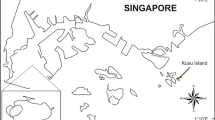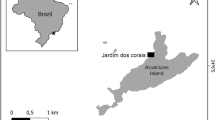Abstract
Coral associated bacterial community potentially has functions relating to coral health, nutrition and disease. Culture-free, 16S rRNA based techniques were used to compare the bacterial community of coral tissue, mucus and seawater around coral, and to investigate the relationship between the coral-associated bacterial communities and environmental variables. The diversity of coral associated bacterial communities was very high, and their composition different from seawater. Coral tissue and mucus had a coral associated bacterial community with higher abundances of Gammaproteobacteria. However, bacterial community in seawater had a higher abundance of Cyanobacteria. Different populations were also found in mucus and tissue from the same coral fragment, and the abundant bacterial species associated with coral tissue was very different from those found in coral mucus. The microbial diversity and OTUs of coral tissue were much higher than those of coral mucus. Bacterial communities of corals from more human activities site have higher diversity and evenness; and the structure of bacterial communities were significantly different from the corals collected from other sites. The composition of bacterial communities associated with same coral species varied with season’s changes, geographic differences, and coastal pollution. Unique bacterial groups found in the coral samples from more human activities location were significant positively correlated to chemical oxygen demand. These coral specific bacteria lead to coral disease or adjust to form new function structure for the adaption of different surrounding needs further research.






Similar content being viewed by others
References
Amann R, Ludwig W, Schleifer KH (1995) Phylogenetic identification and in situ detection of individual microbial cells without cultivation. FEMS Microbiol Rev 59:143–169
Baker AC (2003) Flexibility and specificity in coral algal symbiosis: diversity, ecology, and biogeography of Symbiodinium. Annu Rev Ecol Evol S 34:661–689
Ben-Haim Y, Zicherman-Keren M, Rosenberg E (2003) Temperature-regulated bleaching and lysis of the coral Pocilloporadamicornis by the novel pathogen Vibrio coralliilyticus. Appl Environ Microb 69:4236–4242
Bourne DG, Munn CB (2005) Diversity of bacteria associated with the coral Pocillopora damicornis from the Great Barrier Reef. Environ Microbiol 7:1162–1174
Chen CP, Tseng CH, Chen CA, Tang SL (2011) The dynamics of microbial partnerships in the coral Isopora palifera. ISME J 5:728–740
Cole JR, Chai B, Farris RJ, Wang Q, Kulam SA, McGarrell DM, Garrity GM, Tiedje JM (2005) The Ribosomal Database Project (RDP-II): sequences and tools for high-throughput rRNA analysis. Nucleic Acids Res 33:294–296
Cooney RP, Pantos O, Le Tissier MDA, Barer MR, O’Donnell AG, Bythell JC (2002) Characterization of the bacterial consortium associated with black band disease in coral using molecular microbiological techniques. Environ Microbiol 4:401–413
Croquer A, Bastidas C, Elliott A, Sweet M (2013) Bacterial assemblages shifts from healthy to yellow band disease states in the dominant reef coral Montastraea faveolata. Environ Microbiol Rep 5(1):90–96
Frias-Lopez J, Zerkle A, Bonheyo G, Fouke B (2002) Partitioning of bacterial communities between seawater and healthy, black band diseased, and dead coral surfaces. Appl Environ Microb 68:2214–2228
Guppy R, Bythell JC (2006) Environmental effects on bacterial diversity in the surface mucus layer of the reef coral Montastraea faveolata. Mar Ecol Prog Ser 328:133–142
Huang LM, Tan YH, Song XY, Huang XP, Wang HK, Dong JD (2003) The Status of ecological environment and a proposed protection strategy in Sanya Bay, Hainan Island, China. Mar Pollut Bull 47:180–186
Kimes NE, Van Nostrand JD, Weil E, Zhou J, Morris PJ (2010) Microbial functional structure of Montastraea faveolata, an important Caribbean reef-building coral, differs between healthy and yellow-band diseased colonies. Environ Microbiol 12(2):541–556
Koren O, Rosenberg E (2006) Bacteria associated with mucus and tissues of the coral Oculinapatagonicain summer and winter. Appl Environ Microb 72:5254–5259
Koren O, Rosenberg E (2008) Bacteria associated with the bleached and cave coral Oculina patagonica. Microb Ecol 55:523–529
Kushmaro A, Loya Y, Fine M, Rosenberg E (1996) Bacterial infection and coral bleaching. Nature 380:396
Kvennefors ECE, Sampayo E, Ridgway T, Barnes AC, Hoegh-Guldberg O (2010) Bacterial communities of two ubiquitous Great Barrier Reef corals reveals both site- and species-specificity of common bacterial associates. PLoS One 5:e10401
Lesser MP, Mazel CH, Gorbunov MY, Falkowski PG (2004) Discovery of symbiotic nitrogen-fixing cyanobacteria in corals. Science 305:997–1000
Li J, Chen Q, Zhang S, Huang H, Yang J, Tian XP, Long LJ (2013) Highly heterogeneous bacterial communities associated with the South China sea reef corals Poriteslutea, Galaxea fascicularis and Acropora millepora. PLoS One 8(8):e71301
Littman RA, Willis BL, Pfeffer C, Bourne D (2009) Diversities of coral-associated bacteria differs with location, but not species, for three Acroporid corals on the Great Barrier Reef. FEMS Microbiol Ecol 68:152–163
Liu ZF, Huang W, Li JR, Wang PX, Wang RJ (2009) Sedimentology. In: Wang P, Li Q (eds) The south china sea, developments in paleo environmental research. Springer Science + Bussiness Media B V, Dordrecht, pp 229–236
Meron D, Rodolfo-Metalpa R, Cunning R, Baker AC, Fine M, Banin E (2012) Changes in coral microbial communities in response to a natural pH gradient. ISME J 6(9):1775–1785
Mouchka ME, Hewson I, Harvell CD (2010) Coral-associated bacterial assemblages: current knowledge and the potential for climate-driven impacts. Integr Comp Biol 50(4):662–674
Mulhall M (2009) Saving the rainforests of the sea: an analysis of international efforts to conserve coral reefs. Duke Environmental Law & Policy Forum 19:321–351
Muzyer G, De-Waal EC, Uitterlinden AG (1993) Profiling of complex microbial populations by denaturing gradient gel electrophoresis analysis of polymerase chain reaction-amplified genes coding for 16s rRNA. Appl Environ Microb 59(3):695–700
Raina JB, Tapiolas D, Willis BL, Bourne DG (2009) Coral-associated bacteria and their role in the biogeochemical cycling of sulfur. Appl Environ Microb 75(11):3492–3501
Reshef L, Koren O, Loya Y, Zilber-Rosenberg I, Rosenberg E (2006) The coral probiotic hypothesis. Environ Microbiol 8(12):2068–2073
Roder C, Arif C, Bayer T, Aranda M, Daniels C, Shibl A, Chavanich S, Voolstra CR (2014) Bacterial profiling of white plague disease in a comparative coral species framework. ISME J 8(1):31–39
Rohwer F, Kelley S (2004) Culture-independent analyses of coral-associated microbes. In: Rosenberg E, Loya Y (eds) Coral health and disease. Springer, Heidelberg, pp 265–275
Rohwer F, Breitbart M, Jara J, Azam FN, Knowlton N (2001) Diversity of bacteria associated with the caribbean coral Montastraea franksi. Coral Reefs 20:85–91
Rohwer F, Seguritan V, Azam F, Knowlton N (2002) Diversity and distribution of coral-associated bacteria. Mar Ecol Prog Ser 243:1–10
Rosenberg E, Kushmaro A (2011) Microbial diseases of corals: pathology and ecology. In: Dubinsky Z, Stambler N (eds) Coral reefs: an ecosystem in transition. Springer, New York, pp 451–464
Rosenberg E, Kellogg CA, Rohwer F (2007a) Coral microbiology. Oceanography 20(2):146–154
Rosenberg E, Koren O, Reshef L, Efrony R, Zilber-Rosenberg I (2007b) The role of microorganisms in coral health, disease and evolution. Nat Rev Microbiol 5:355–362
Schloss PD, Handelsman J (2005) Introducing DOTUR, a computer program for defining operational taxonomic units and estimating species richness. Appl Environ Microbiol 71:1501–1506
Shashar N, Cohen Y, Loya Y, Sar N (1994) Nitrogen fixation (acetylene reduction) in stony corals: evidence for coral-bacteria interactions. Mar Ecol Prog Ser 111:259–264
Wegley L, Edwards R, Rodriguez-Brito B, Liu H, Rohwer F (2007) Metagenomic analysis of the microbial community associated with the coral Porites astreoides. Environ Microbiol 9:2707–2719
Williams WM, Viner AB, Broughton WJ (1987) Nitrogen fixation (acetylene reduction) associated with the living coral Acropora variabilis. Mar Biol 94:531–535
Zhang YY, Dong JD, Yang ZH, Zhang S, Wang YS (2008) Phylogenetic diversity of nitrogen-fixing bacteria in mangrove sediments assessed by PCR—denaturing gradient gel electrophoresis. Arch Microbiol 190:19–28
Zhang YY, Dong JD, Yang B, Ling J, Wang YS, Zhang S (2009) Bacterial community structure of mangrove sediments in relation to environmental variables accessed by 16S rRNA gene-denaturing gradient gel electrophoresis fingerprinting. Sci Mar 73(3):487–498
Acknowledgments
The research was supported by the National “863” High Technology Research and Development Program of China (No. 2012AA092104, No. 2013AA092901 and No. 2013AA092902), Strategic Priority Research Program of the Chinese Academy of Sciences (No. XDA11020202), the National Natural Science Foundation of China (No. 41276113, No. 41276114, No. 31270528, No. 41206082 and No. 41006069), Science and technology cooperation Projects of Sanya (No. 2013YD74), and the Sanya Station Database and the Information System of CERN, the Knowledge Innovation Program of the Chinese Academy of Sciences (No. SQ201218), the Open Fund of Key Laboratory for Ecological Environment in Coastal Areas, State Oceanic Administration (No. 201304), the key laboratory of marine ecology and environmental science and engineering, SOA (No. MESE-2013-02) and the key Laboratory for ecological environment in coastal areas, State Oceanic Administration (No. 201211).
Conflict of interest
The authors declare that they have no conflict of interests.
Author information
Authors and Affiliations
Corresponding author
Rights and permissions
About this article
Cite this article
Zhang, YY., Ling, J., Yang, QS. et al. The diversity of coral associated bacteria and the environmental factors affect their community variation. Ecotoxicology 24, 1467–1477 (2015). https://doi.org/10.1007/s10646-015-1454-4
Accepted:
Published:
Issue Date:
DOI: https://doi.org/10.1007/s10646-015-1454-4




